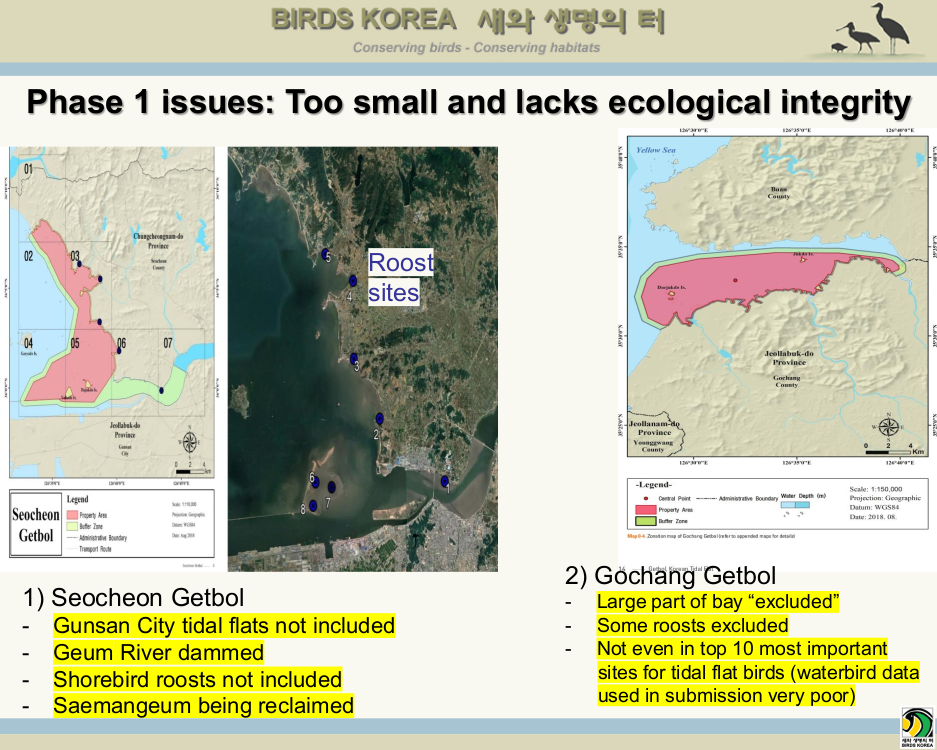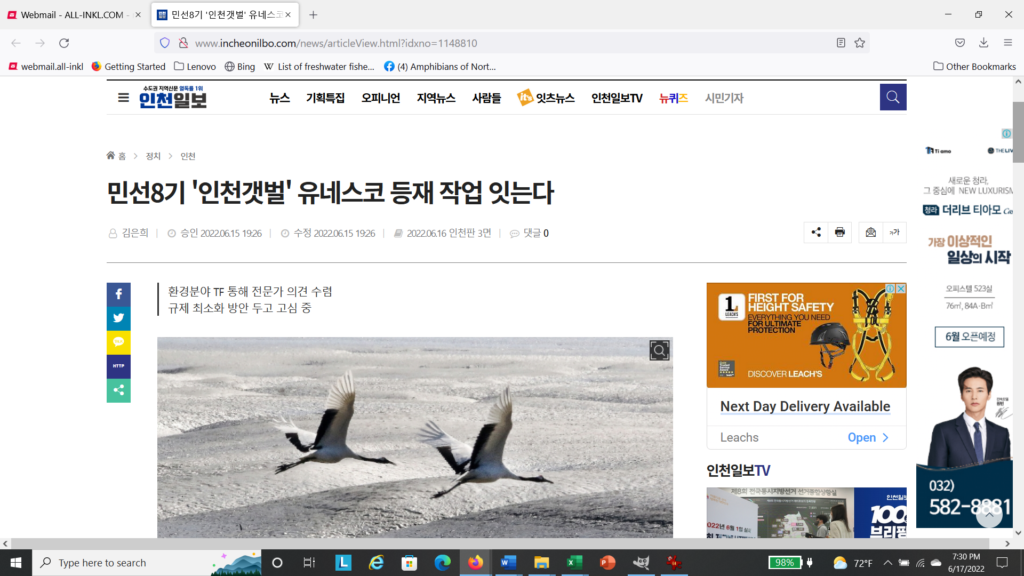Dr Nial Moores, Birds Korea, June 17th 2022
The submission of a natural site as a World Heritage Property is widely understood to be the strongest commitment that a national government can take to conserving the Outstanding Universal Value of that site. Before submission, the site must be permanently legally protected, and a management team should be in place. For each site too, the “boundaries should reflect the spatial requirements of habitats, species, processes or phenomena that provide the basis for their inscription on the World Heritage List” (World Heritage Operational Guidelines 2021). For a Getbol or tidal flat site, this includes e.g., high tide shorebird roost sites and breeding sites of tidal flat obligate species.
In 2021, four tidal flat areas in the southwest of the Republic of Korea were designated unde Phase One of the Korean Getbol World Heritage Serial Property, part of a process to be undertaken in at least two phases (with Phase Two to be considered for designation in 2025). The designation last year was made by the UNESCO World Heritage Committee in spite of advice given by the IUCN, the formal advisors on Natural World Heritage Sites, to defer designation until improvements had been made to the ROK’s submission.
The IUCN’s reasoning is explained at length in the IUCN formal technical review of May 2020 (accessible online on the World Heritage website) and includes the following: “the component parts lack size to represent complete and intact geomorphological processes (viii), ecological processes (ix) and habitats (x); “Important habitats and breeding sites …are missing” (using Chinese Crested Tern 뿔제비갈매기 (CR), Black-faced Spoonbill 저어새 (EN), Chinese Egret 노랑부리백로 (VU), Saunders’s Gull 검은머리갈매기 (VU) and Swan Goose 개리 (VU) as example species); and “the boundaries of the nominated property do not meet the requirements of the Operational Guidelines.”

To put this in simpler terms: although the four sites are important each in their own way, they do not conserve properly the Outstanding Universal Value of the ROK’s tidal flats. They omit many high tide roosts; and they do not include whole ecosystems. Instead, three of the four sites have boundaries set clearly by administrative and not ecological parameters.
These issues need to be addressed and fixed by 2024 or at latest by 2025.
According to formal documents submitted during Phase One, the ROK also committed itself to designating another nine tidal flat sites for Phase Two. Supplementary materials submitted by the ROK UNESCO Committee state that Phase Two should focus on tidal flats influenced by the Han River. They therefore identified the following as potential sites: Han-Imjin Estuary (Gimpo and Paju Cities, Gyeonggi Province), Ganghwa Tidal Flats (Incheon), Yeonjong Tidal Flats (Incheon), Songdo Tidal Flats (Incheon), the Hwaseong Wetlands (Hwaseong City, Gyeonggi Province) and Asan Bay (Pyeongtaek City, Gyeonggi Province, and Dangjin City, Chungcheongnam Province), and Garolim Bay (Chungcheongnam Province). Some counts from these sites can be found on our blog and especially in our archived website.
Birds Korea is also calling for the Yeonggwang County-Baeksu tidal flats and adjacent inshore waters in Jeollanam to be considered, in large part because this area includes the only known breeding site of Chinese Crested Tern in the ROK, along with nesting Black-faced Spoonbills and Chinese Egrets and large numbers of foraging shorebirds.
The timing of this World Heritage process is fixed by the calendar of the UNESCO World Heritage Committee. Accordingly, by autumn 2023 (i.e., in only 15 months), potential Phase Two sites need to be identified and legal protections set out. In 2024, the IUCN will then review these potential sites and provide technical support so that the Korean Getbol World Heritage Property (the combination of Phase One and Phase Two sites) can truly capture and conserve the Outstanding Universal Values of Korean tidal flats. In 2025, the UNESCO World Heritage Committee will then decide whether or not this combined “Korean Getbol” Serial Property meets their global gold standard.
During the Phase One process concerns were expressed by many NGOs (including Birds Korea) and by many affected local communities that they did not feel properly involved in the process; and that many of the most important sites were not considered. In addition, as the Phase One submission materials are only available in English, many people considered both the process and the conclusions to be impenetrable.
In order to increase involvement, awareness and participation this year and next, Ms Kim Choony, Secretary General of the National Korean Federation for Environmental Movements (KFEM) therefore recommended setting up a dedicated Task Force. Consensus-building meetings were then held by this newly-formed Task Force formed of key KFEM offices and advisors (including myself and Professor Ryu Jong Seong of Anyang University) in March, April and May.


These meetings were then followed by the first public consensus-building meeting in Incheon on June 8th. This public meeting, excellently organized by Incheon KFEM and held in the Incheon YWCA, involved staff from Incheon KFEM, Incheon Green Korea, the Incheon Council for Sustainable Development, Incheon City and activists working for the conservation of Black-faced Spoonbills.


I presented on behalf of Birds Korea at the meeting, and Ms Ku Yeonah (Local Project Coordinator, East Asian-Australasian Flyway Partnership Secretariat) both translated and also helped to add further insights and context.
It is expected that these meetings will continue to grow in depth and engagement during the coming months. This is to ensure that national and local NGOs will be in a much stronger position to discuss the Korean Getbol World Heritage process with local communities, local government officials, key ministries and the Phase Two Promotion Committee, which will apparently start work this month.
There is very little time remaining to identify and get the most appropriate sites legally protected in time for World Heritage designation. It is therefore heartening to see that, only a week after the meeting in Incheon, the Incheon Ilbo reported that the city is now considering proposing tidal flat in Incheon for Phase Two designation.
Let us do all we can to make this a genuinely historic period for tidal flat conservation in the ROK!

